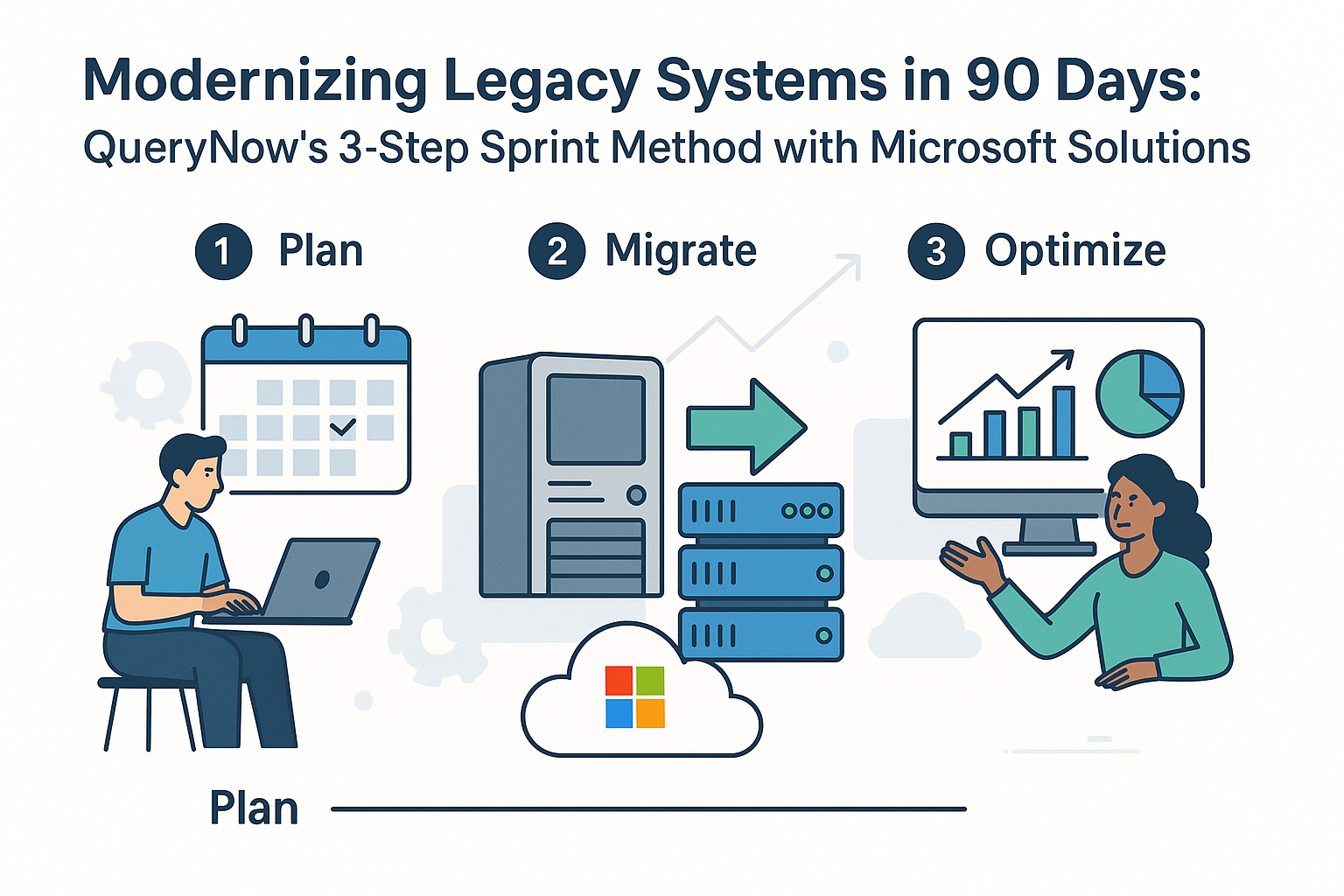
The 90-Day Modernization Framework
Legacy system modernization typically takes 18-36 months. Most projects overrun timelines and budgets. Many fail entirely, leaving organizations with partially modernized systems worse than what they started with.
QueryNow has refined a different approach: structured 90-day sprints that deliver production results fast, minimize risk, and build momentum for continued transformation. This is not about cutting corners—it is about focusing ruthlessly on business value and eliminating waste.
The Three-Phase Sprint Structure
Phase 1: Assess and Prioritize (Weeks 1-2)
We start with rapid assessment identifying exactly what holds your organization back and which modernization initiatives deliver maximum business impact.
Activities:
- Technical architecture review identifying bottlenecks and risks
- Business process analysis finding where legacy systems constrain operations
- Stakeholder interviews understanding pain points across the organization
- Data architecture assessment evaluating readiness for modern applications
- Quick win identification finding improvements deliverable in weeks
Deliverables:
- Prioritized modernization roadmap aligned with business objectives
- Risk assessment with specific mitigation strategies
- Resource requirements and team structure recommendations
- Success metrics and validation criteria
Phase 2: Build and Validate (Weeks 3-10)
With clear priorities established, we execute rapid development using proven patterns and Microsoft technologies that accelerate delivery.
Week 3-6: Core Development
- Infrastructure provisioning on Azure
- Application development using modern frameworks
- API development for system integration
- Data migration and synchronization setup
Week 7-8: Integration and Testing
- Integration with existing systems
- Automated testing implementation
- Performance optimization
- Security hardening and compliance validation
Week 9-10: User Validation
- User acceptance testing with business stakeholders
- Refinement based on feedback
- Documentation and training material creation
- Deployment preparation
Phase 3: Deploy and Optimize (Weeks 11-12)
We deploy to production using gradual rollout strategies that minimize risk, then optimize based on real-world usage.
Activities:
- Staged production deployment starting with pilot users
- Monitoring and performance tuning
- User training and support
- Issue resolution and refinement
- Success metrics tracking and reporting
Real-World Examples
Financial Services: Document Processing
A regional bank processed loan applications manually—scanning documents, extracting data, routing for approval. Processing took 3-5 days. Error rates were high.
In 90 days, we deployed AI-powered document processing using Azure AI services. The system automatically extracts data from applications, validates information, and routes intelligently.
Results: Processing time reduced to 4 hours. Error rate dropped 90%. Customer satisfaction improved dramatically. ROI achieved in 5 months.
Manufacturing: Production Monitoring
A automotive parts supplier had limited visibility into production floor operations. Problems were not detected until end-of-shift reports. Quality issues were caught late.
In 90 days, we deployed real-time production monitoring with IoT sensors and Power BI dashboards. Operators and managers gained instant visibility into line performance.
Results: 30% reduction in defects through early detection. 20% decrease in unplanned downtime. Production efficiency improved 15%.
Healthcare: Patient Scheduling
A hospital network relied on manual scheduling that could not optimize capacity utilization. Wait times were long. No-show rates were high. Revenue was lost to unfilled slots.
In 90 days, we deployed intelligent scheduling using AI that optimizes capacity, predicts no-shows, and enables online booking integrated with their EHR.
Results: Wait times reduced 40%. No-show rate decreased 35%. Revenue increased through better capacity utilization.
Why 90 Days Works
Forces Prioritization: Limited time forces focus on what truly matters—business value over technical perfection.
Maintains Momentum: Quick wins build organizational confidence and secure continued investment.
Reduces Risk: Smaller scope means less can go wrong. Problems are caught and addressed quickly.
Validates Assumptions: Real-world deployment in 90 days tests assumptions that might be wrong—before investing years in the wrong direction.
Enables Learning: Teams learn modern technologies on real projects, building capability faster than training alone ever could.
What Makes It Possible
Proven Patterns: We do not invent solutions from scratch. We apply patterns that worked dozens of times before.
Cloud-Native Platforms: Azure provides infrastructure, services, and capabilities that eliminate months of undifferentiated work.
Focused Scope: We tackle one high-value problem well rather than attempting comprehensive transformation.
Experienced Team: Our engineers have built hundreds of modernization projects. They know what works and what does not.
Agile Execution: Weekly sprints, daily standups, continuous integration—modern practices that deliver results fast.
Common Misconceptions
Fast Means Low Quality: False. Quality comes from discipline, not duration. Automated testing, continuous integration, and code reviews ensure quality regardless of timeline.
Everything Must Be Perfect: False. Production deployment does not mean feature-complete. It means delivering core value with room to iterate based on usage.
Traditional Planning Is Necessary: False. Extensive upfront planning is waste when requirements will change. We plan just enough to start, then adapt continuously.
You Need Complete Requirements: False. Perfect requirements are impossible. Starting with clear business objectives and iterating based on feedback works better than trying to define everything upfront.
Getting Started
If your organization needs legacy modernization but cannot afford years of transformation projects, 90-day sprints offer a proven alternative.
Ready to modernize fast? Contact QueryNow for a 90-day sprint assessment. We will identify your highest-impact modernization opportunity and show you exactly what is achievable in 90 days with our proven methodology.


